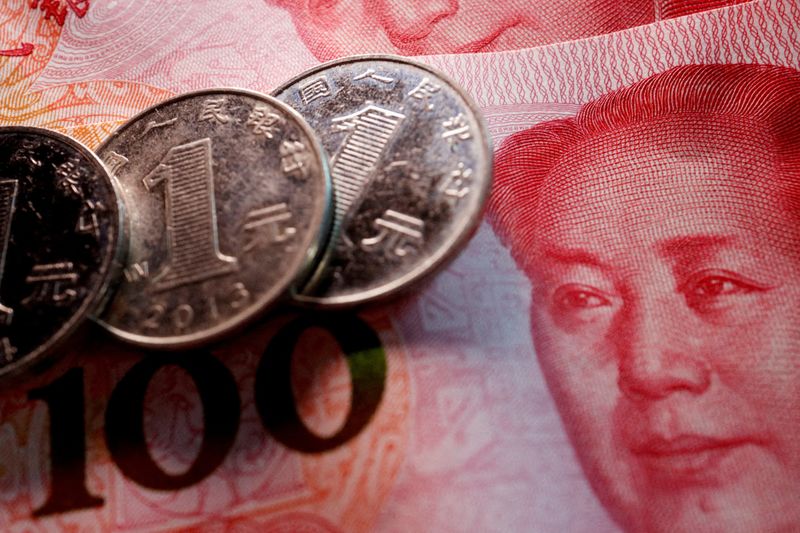Forex
China state banks seen mopping up offshore yuan to stem currency weakness


© Reuters. FILE PHOTO: Coins and banknotes of China’s yuan are seen in this illustration picture taken February 24, 2022. REUTERS/Florence Lo/Illustration/File Photo
SHANGHAI (Reuters) -China’s major state-owned banks were seen actively mopping up the on Monday, three people with knowledge of the matter said, as the currency comes under growing pressure from a darkening economic outlook and strain in the property sector.
State banks often act as agents for China’s central bank in the offshore foreign exchange market, but they could also trade on their own behalf or execute their clients’ orders.
Tightening up offshore yuan liquidity could also act to stabilise the yuan, one of the sources said.
The move effectively raised the cost of shorting the Chinese yuan, at a time the local unit is facing mounting depreciation pressure.
Following the state bank move, the offshore yuan rallied and was last trading at around 7.2834 per dollar, up around 0.3% on the day. The was also firmer at around 7.28 per dollar.
The yuan has weakened more than 5% against the greenback so far this year, reflecting growing concerns about the outlook for the world’s No.2. economy.
Earlier on Monday, China cut its one-year benchmark lending rate as authorities seek to ramp up efforts to stimulate credit demand, but surprised markets by keeping the five-year rate unchanged amid broader concerns about a rapidly weakening currency.
“Probably China limited the size and scope of rate cuts because they are concerned about downward pressure on the RMB (renminbi),” said Masayuki Kichikawa, chief macro strategist at Sumitomo Mitsui (NYSE:) DS Asset Management.
“Chinese authorities care about currency market stability.”
This month alone, the yuan has weakened almost 2% versus the greenback.
The cost of shorting the yuan jumped, the state bank sources told Reuters, as seen from sudden rises in offshore yuan tomorrow-next forward points.
Using FX swaps to raise the cost of shorting the currency is the key tool authorities have used in the past to influence the direction of the yuan.
During London trade, offshore yuan forwards jumped across the board amid signs of yuan liquidity tightness, with several banking sources attributing the liquidity squeeze to the activity by banks.
The one-month dollar/yuan forwards traded offshore touched the highest level in a year.
Sources told Reuters last week that China’s major state-owned banks were seen busy selling U.S. dollars to buy yuan in both onshore and offshore spot foreign exchange markets, in an bid to arrest the yuan’s rapid losses.
“The PBOC (People’s Bank of China) has visibly stepped up its efforts to restrain the renminbi’s depreciation trend lately, but Beijing’s unwillingness to countenance more radical monetary and fiscal stimulus implies that the exchange rate will necessarily need to bear some of the burden of supporting the floundering economy through further depreciation,” Alvin Tan, head of Asia FX at RBC Capital Markets, said in a note.
Earlier on Monday, UBS cut its China 2023 real GDP growth forecast to 4.8% from 5.2%.
As long as uncertainty over the direction of Chinese efforts to shore up the economy remained, foreign investor sentiment towards China broadly would likely remain cautious, analysts said.

 Forex3 years ago
Forex3 years agoForex Today: the dollar is gaining strength amid gloomy sentiment at the start of the Fed’s week

 Forex3 years ago
Forex3 years agoUnbiased review of Pocket Option broker

 Forex3 years ago
Forex3 years agoDollar to pound sterling exchange rate today: Pound plummeted to its lowest since 1985

 Forex3 years ago
Forex3 years agoHow is the Australian dollar doing today?

 Cryptocurrency3 years ago
Cryptocurrency3 years agoWhat happened in the crypto market – current events today

 World3 years ago
World3 years agoWhy are modern video games an art form?

 Commodities3 years ago
Commodities3 years agoCopper continues to fall in price on expectations of lower demand in China

 Economy3 years ago
Economy3 years agoCrude oil tankers double in price due to EU anti-Russian sanctions





















